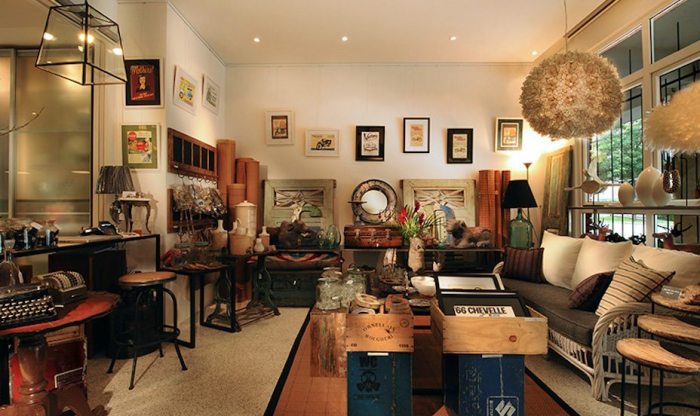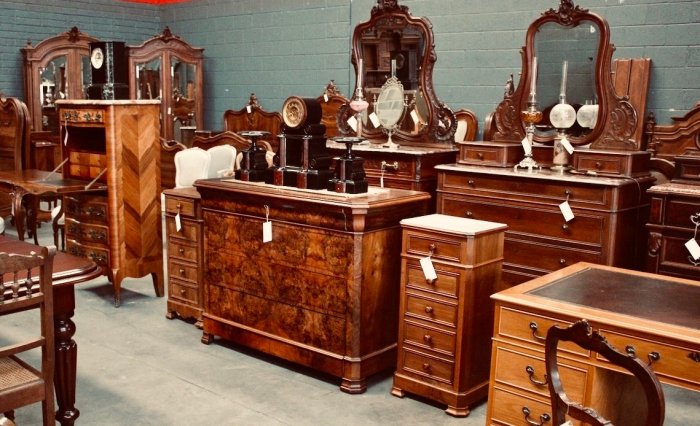
The allure of vintage furniture lies in its unique blend of history, craftsmanship, and enduring style. More than just décor, these pieces whisper stories of bygone eras, offering a tangible connection to the past. Finding the perfect vintage piece, however, requires careful consideration; this guide navigates the world of vintage furniture stores, helping you locate reputable sources, understand pricing, and make informed decisions.
From identifying authentic antique shops to navigating online marketplaces, we explore the diverse landscape of vintage furniture retail. We delve into the criteria for assessing quality, discuss the various styles and trends, and provide practical tips for care and restoration. Ultimately, this guide empowers you to confidently curate a collection that reflects your personal style and enhances your living space.
Defining “Best” in Vintage Furniture

Defining what constitutes “best” in the world of vintage furniture is a multifaceted endeavor, encompassing a blend of objective criteria and subjective preferences. While certain aspects, such as the quality of materials and craftsmanship, lend themselves to objective assessment, the ultimate judgment of “best” often hinges on individual tastes and the context in which the furniture is appreciated.
This inherent subjectivity makes the quest for the “best” vintage piece a deeply personal journey. What one person considers a stunning example of mid-century modern design, another might find underwhelming. Factors such as historical context, personal style, and even emotional attachment play a significant role in shaping individual perceptions of value.
Criteria for Assessing Vintage Furniture Quality
Several key factors contribute to the overall assessment of a vintage furniture piece’s quality. These factors, when considered together, offer a more comprehensive understanding of its value and desirability. The following table Artikels these crucial aspects:
| Quality of Materials | Craftsmanship | Design Aesthetic | Historical Significance |
|---|---|---|---|
| The type and quality of wood (e.g., solid mahogany vs. veneer), the durability of upholstery fabrics, and the resilience of hardware all impact longevity and value. Solid wood pieces, for instance, tend to be more valuable and durable than those made with particleboard or other composite materials. | The precision of joinery, the smoothness of finishes, and the overall attention to detail are indicative of high-quality craftsmanship. Hand-carved details, intricate inlay work, and robust construction are hallmarks of superior craftsmanship. | The piece’s style, its conformity to a particular design movement (e.g., Art Deco, Mid-Century Modern), and its overall visual appeal contribute significantly to its desirability. A piece’s aesthetic aligns with current design trends and individual preferences. | The historical context of a piece—its maker, the period it was produced, and any notable associations—can significantly enhance its value. A piece associated with a famous designer or a significant historical event will often command a higher price. |
Subjective Nature of “Best”
The perception of “best” in vintage furniture is inherently subjective. Individual preferences for style, color, and material significantly influence which pieces are considered most desirable. For example, a collector specializing in Danish modern design might deem a Hans Wegner chair the “best,” while someone drawn to Art Deco aesthetics might favor a glamorous chaise lounge. The “best” piece is therefore a reflection of individual taste and collecting focus.
Valuing Vintage Furniture: Monetary vs. Sentimental Value
The value of vintage furniture can be assessed in multiple ways, extending beyond its monetary worth. While market price and auction records provide a tangible measure of value, sentimental and artistic value often hold greater significance for individual owners. A family heirloom, for example, might possess immense sentimental value, far exceeding its market price. Similarly, a piece’s artistic merit, as reflected in its design and craftsmanship, can be a primary driver of its value to a collector, regardless of its monetary worth.
The interplay between these different forms of value is complex and personal.
Types of Vintage Furniture Stores

Navigating the world of vintage furniture requires understanding the diverse landscape of retail options. Each type of store offers a unique blend of advantages and disadvantages, impacting factors like price, selection, and the authenticity of the pieces. Choosing the right store depends on your budget, desired style, and comfort level with the verification process.
Different types of stores cater to various needs and preferences. Understanding their distinctions is key to a successful vintage furniture shopping experience.
Types of Vintage Furniture Stores and Their Characteristics
Several distinct types of stores specialize in selling vintage furniture. Each offers a unique shopping experience with its own set of pros and cons.
- Antique Shops: These stores typically specialize in furniture and decorative items that are at least 100 years old. They often focus on higher-end pieces and offer expert appraisal and restoration services.
- Consignment Stores: These stores sell items on behalf of private individuals, offering a wide variety of styles and price points. Items are usually vetted for quality and condition by the store owner.
- Online Marketplaces (e.g., eBay, Etsy): These platforms provide a vast selection of vintage furniture from sellers across the globe. However, careful vetting is crucial due to the increased risk of scams and misrepresented items.
- Auction Houses: These venues offer a competitive bidding environment for vintage furniture, often including rare and high-value pieces. Successful bidding requires prior research and a clear understanding of market values.
- Thrift Stores and Flea Markets: These often offer lower prices and a chance to discover unexpected treasures, but require more time and effort to search through a larger selection of varied items. Authenticity is not always guaranteed.
Advantages and Disadvantages of Each Store Type
A thorough evaluation of the pros and cons of each type of store helps buyers make informed decisions.
- Antique Shops: Advantages include expert authentication, restoration services, and often higher-quality pieces. Disadvantages are higher prices and a more limited selection.
- Consignment Stores: Advantages include a wide variety of styles and price points, often with good quality control. Disadvantages can include less expertise in authentication compared to antique shops and a potentially faster turnover of inventory.
- Online Marketplaces: Advantages include vast selection and convenience. Disadvantages include increased risk of scams, difficulty in verifying authenticity, and higher shipping costs.
- Auction Houses: Advantages include the possibility of finding unique and rare pieces at competitive prices. Disadvantages include the pressure of bidding, potential for high final prices, and the need for expertise in assessing value.
- Thrift Stores and Flea Markets: Advantages include the potential for finding incredible bargains and unique items. Disadvantages include a lack of guaranteed quality or authenticity, and the time investment required to find desirable pieces.
Comparison of Vintage Furniture Store Types
This table summarizes the key differences between the various store types to aid in decision-making.
| Store Type | Pricing | Selection | Authenticity Verification | Customer Service |
|---|---|---|---|---|
| Antique Shop | High | Limited, curated | High | Generally good, expert knowledge |
| Consignment Store | Medium | Moderate, varied | Moderate | Variable, depends on store |
| Online Marketplace | Variable, often competitive | Vast, diverse | Low, buyer beware | Variable, relies on seller communication |
| Auction House | Variable, competitive bidding | Varied, often high-end | Variable, depends on auction house reputation | Variable, depends on auction house size and reputation |
| Thrift Store/Flea Market | Low | Vast, uncurated | Low | Minimal to none |
The journey of discovering and acquiring vintage furniture is a rewarding one, blending the thrill of the hunt with the satisfaction of owning a piece of history. By understanding the nuances of different stores, appreciating the artistry of various styles, and mastering the art of preservation, you can create a home environment rich in character and lasting appeal. Remember, the best vintage furniture is not just aesthetically pleasing but also tells a story, reflects your taste, and contributes to a sustainable lifestyle.
FAQ Guide
How do I authenticate a vintage furniture piece?
Examine construction details, hardware, and maker’s marks. Research the piece’s style and compare it to known examples. Consulting with an appraiser or expert can provide further verification.
What are common red flags when buying vintage furniture?
Unusually low prices, significant damage not disclosed, unclear provenance, and inconsistent descriptions are all potential warning signs.
How often should I clean my vintage furniture?
Regular dusting is essential. More thorough cleaning should be done as needed, depending on the material and finish. Always use appropriate cleaning products to avoid damage.
Where can I find reliable information on vintage furniture styles?
Books on furniture history, online resources such as museum websites and style guides, and antique shows are all valuable resources for learning about specific styles.





